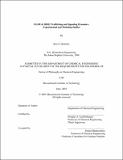EGFR & HER2 trafficking and signaling dynamics : experimental and modeling studies
Author(s)
Hendriks, Bart S. (Bart Sebastian), 1976-
DownloadFull printable version (14.84Mb)
Alternative title
Epidermal growth factor receptor & human epidermal growth-two trafficking and signaling dynamics
Other Contributors
Massachusetts Institute of Technology. Dept. of Chemical Engineering.
Advisor
Douglas A. Lauffenburger.
Terms of use
Metadata
Show full item recordAbstract
EGFR and HER2 expression levels have distinguished themselves as important factors in contributing to various types of cancers including breast and ovarian cancers, but quantitative linkages between receptor expression levels and aberrant cell behaviors are not well understood. The ability to interpret and predict cell responses in a multi-parameter space will be vital in efforts to manipulate cell behavior for therapeutic purposes. HER2 acts as a co-receptor of the EGFR family of receptor tyrosine kinases. HER2 does not bind any known ligand, but plays an active signaling role following heterodimerization with a ligand-bound EGFR family receptor. EGFR family receptors undergo a dynamic process termed trafficking in which receptors and ligands are internalized and then either recycled to the surface or targeted for degradation. Trafficking is intimately connected to cell signaling by controlling the quantity and location of ligand-receptor complexes and is sensitive to disruption via the overexpression of the receptors involved. In this work, we quantitatively establish the role of HER2 and heterodimerization in EGFR trafficking and signaling. A hierarchy of mathematical models describing the trafficking behavior of EGFR and HER2 was developed at various levels of mechanistic detail. At the macroscopic level the trafficking of EGFR and HER2 fall into two regimes, one whose downregulation is sorting-limited (EGFR) and one whose downregulation is internalization-limited (HER2). (cont.) Subordinate models yield mechanistic detail into the endocytic and endosomal sorting processes supporting the notions that heterodimers internalize as single entities and that HER2 is able to disrupt EGFR sorting through a competitive mechanism. The development of a comprehensive model of EGFR and HER2 trafficking enables the predictions of the quantity and distribution of various receptor species, including homo- and heterodimers as a function of time. Point by point comparison with ERK signaling data for different HER2 expressing cell clones allows the calculation of the signal generated per activated HER2 and per activated EGFR. These results suggest that EGFR and HER2 do not differ significantly in their ERK signaling ability and that HER2-mediated differences in ERK signaling can entirely be explained by interactions at the level of receptor trafficking.
Description
Thesis (Ph. D.)--Massachusetts Institute of Technology, Dept. of Chemical Engineering, 2003. Includes bibliographical references. This electronic version was submitted by the student author. The certified thesis is available in the Institute Archives and Special Collections.
Date issued
2003Department
Massachusetts Institute of Technology. Department of Chemical EngineeringPublisher
Massachusetts Institute of Technology
Keywords
Chemical Engineering.